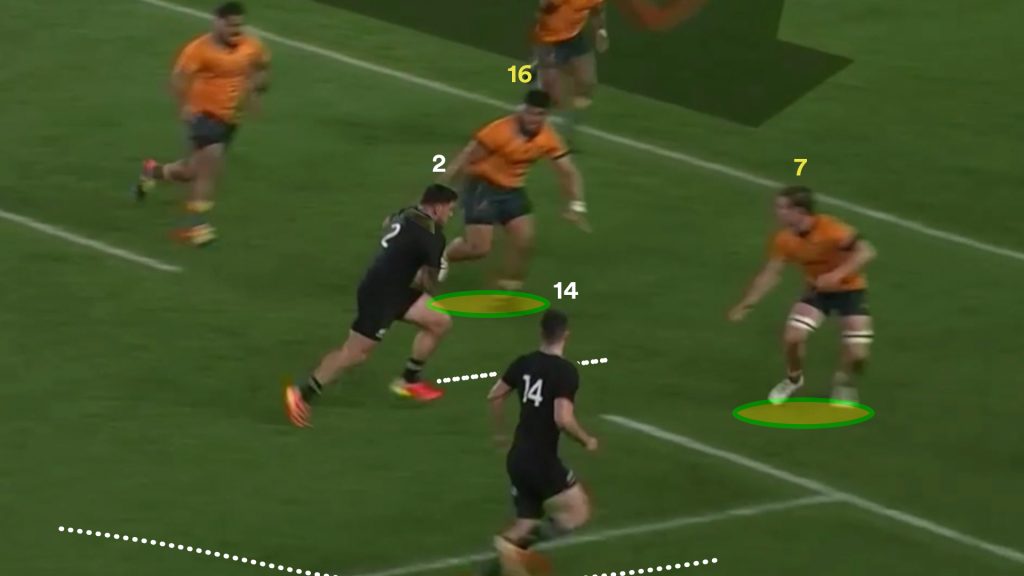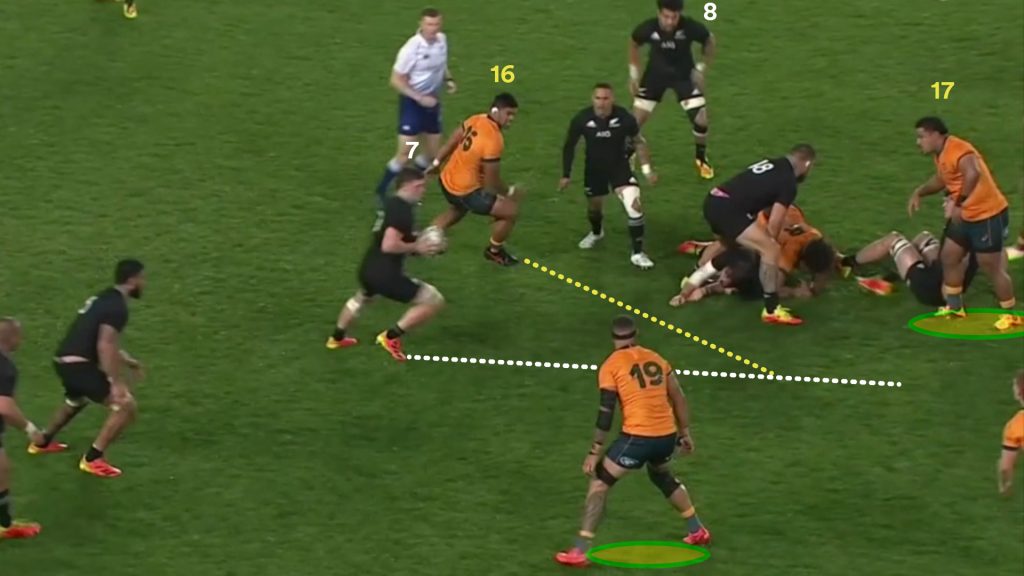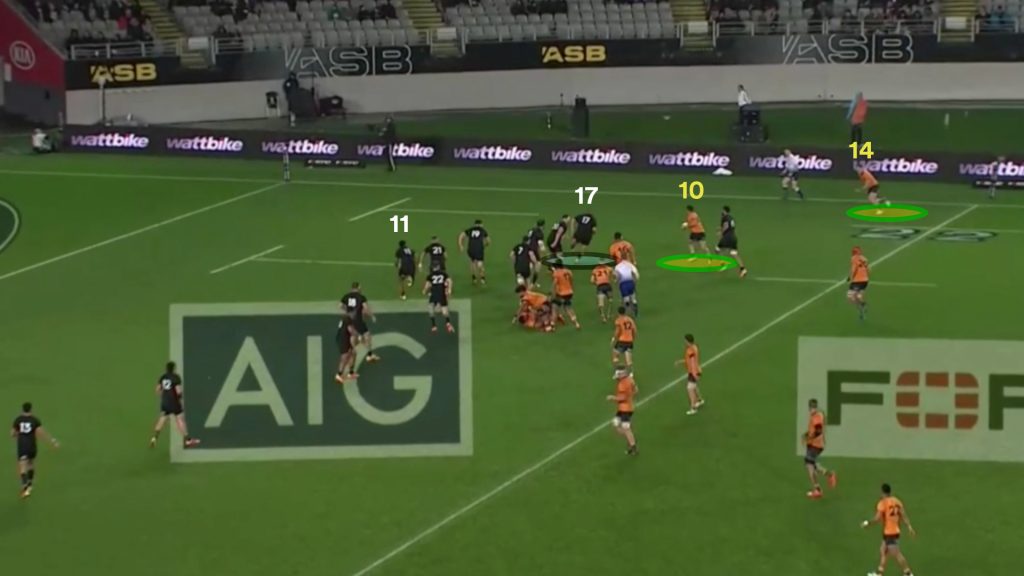Led by a brilliant performance in attack from halfback Tate McDermott, there were periods of good play by the Australians as they once again constructed three tries in defeat to the All Blacks in the second Bledisloe Cup test of 2021.
However, another two intercepts – to go with one in the first match – cost them 14 points, while two further tries to Brodie Retallick and David Havili were scored directly off turnover ball.
Up to 28 points were conceded from error, while defensive issues plagued them at other times throughout the 80 minutes.
If there is one area of the game the Wallabies are conceding points to the All Blacks unnecessarily, it is their effort in scramble defence situations. The Wallabies tight five players, starters and bench reserves, just don’t seem to have the fitness, hustle and decision-making under pressure to match it with the All Blacks in this area of the game, and that leaves them ripe to be plucked.
Despite some lapses which gave the All Blacks an early lead, at 21-15 and six minutes into the second half the Wallabies are still very much in the game when Aaron Smith began to target the Australian tight five after a collapsed line out.
After one carry to the 15-metre line, Smith brought play back towards the touch line with another carry that asked the Wallabies retreating forwards to make another tackle on Akira Ioane.
Patrolling the ruck, young Wallaby lock Darcy Swain (4) made a crucial decision to leave his pillar defence role. Clearly, this was an error of judgement but as the play unfolds the Wallabies make it easy for the All Blacks.


All three tight five forwards on the open side look to see Smith (9) has escaped Swain (4) and is going down the blindside to use the two-on-one.
None seem really that urgent to do anything about it, failing to move at all until Smith has made the line break past McDermott. None are anticipating the break may happen and that there is a need for them to be there, if not to tackle Smith, at least to shut down any support lanes.
All three of them have at least a five-metre head start on Codie Taylor (2), the eventual try scorer, but none think to obstruct him legally, by making it as hard as they can for him to get through.



One guy wants to work and three guys don’t. They don’t react until Smith is through the line, whereas Taylor had anticipated the opportunity as soon as Smith scampered away from the ruck.
There is no urgency from the Wallabies as Taylor is given a free pass without any contact.
They were slow to react initially, unable to fight for every inch and just plainly outworked by the All Blacks hooker. The Wallabies pack can hit hard when they want, but can’t work hard when it’s needed in situations like these it seems.
By the time Taylor is there for the pass from Smith, there isn’t a Wallaby with him as they’ve quit early on the play.

McDermott was able to stay with the speedster Will Jordan, but no one else could get anyone near the 30-year-old Taylor, offering up an easy seven points. If there had been a man next to Taylor, there would be no guarantee that Smith passes the ball and the Wallabies may have scrambled and save the situation. They don’t give themselves that opportunity.
Surrounding players can’t just switch off in test rugby and it’s in those moments where the Wallabies were weakest at Eden Park. There has to be an urgency at all times in defence, anticipation for what might happen, and the effort and drive to be there in case it does.
That effort was the only difference in this situation between the All Blacks hooker and his Wallaby counterparts, something that requires no talent, just desire and application to the situation in front of you to make repeated involvements.
After that, the All Blacks put a penalty goal and an intercept try on the board to essentially end the match at 38-15, but the rampage continued as they sensed a waning forward pack, despite reinforcements from the bench.
Entering the final quarter, the All Blacks call for a switch play, one they have used in the past to target the area where all the tight five forwards are resetting in the defensive line after getting up from the scrum.

On the first phase David Havili (12) carries into the Wallabies 10-12 channel to set up a ruck for the switch. Aaron Smith is right in behind him searching for quick ball while Codie Taylor is up on his feet ready for the switch.

On the second phase, Smith fires the pass directly to Taylor (2) on the edge, with right winger Will Jordan (14) wrapping around as an outside option.
The Wallabies are stuck with two front-rowers and Michael Hooper as the last man on that edge. Taylor doesn’t need Jordan as he crashes over in the one-on-one tackle of Jordan Uelese (16).


It’s a recycled scrum play the All Blacks have used to target teams with immobile or tired front row forwards.
Using the speed of Smith’s pass and the athletic and skills advantages that Taylor has over most front rowers, they can manufacture opportunities with a quick switch following a scrum.
Against South Africa at home in 2018 we see almost the same play. This time, Beauden Barrett is used to give the crash ball to the 12, Ryan Crotty, to set the ruck a little bit wider. The right wing, Ben Smith, is quick to bail at the top of the screen and get back in a position for the wrap-around from Codie Taylor.
The pass from Aaron Smith is expertly placed for Taylor, who commits the last man and sends Ben Smith free down the edge before the All Blacks halfback, running a positive support line, receives the last pass to score the try.
The Wallabies just can’t afford to give the All Blacks easy openings and that’s what continued to happen throughout the second half at Eden Park.
Replicating the same mistake Swain made earlier, Uelese (16) jumps off the line looking to pressure the All Blacks halfback, leaving a half-gap around the ruck exposed at the 64-minute mark.


Despite Uelese flying off the line, Salakaia-Loto (19) and Scott Sio (17) just aren’t anticipating the need to shift inward to close the gap. Sio had a leg hold from Scott Barrett slowing him down, but Salakaia-Loto did not react at all.
The man that does get to Dalton Papalii (7) first is Taniela Tupou (18), from the opposite side outside Sio, but he fails to bring him down on the first contact. The support runner, Ardie Savea (8), finds himself open, as lock Matt Philip doesn’t work off the ball to keep him covered.


When the ball pops free from the Papalii offload into the arms of Savea, it’s McDermott (9) that is tasked with tackling the All Blacks number 8. It’s a mismatch that needs no second invitation, and Savea powers through into the backfield to set up Will Jordan in the corner.
If the Wallabies forwards had worked harder off-the-ball to be in a position to close the play before it happens, they wouldn’t need to be tracking back over 50-metres in scramble situations, or in this case, walking back behind their own posts.
The Wallabies put together their own passages of play that could have led to many try-scoring opportunities. There were great 30-40 metre passages of movement and offloading to march downfield on the All Blacks.
In one such case after winning a turnover, Tom Banks (15) fires a long ball over the top to Hunter Paisami (13) where the All Blacks are thin on the ground. Inside Rieko Ioane (13), the All Blacks have lock Scott Barrett and prop Angus Ta’avao (18) and the Wallabies clearly have the numbers advantage to spark a counter-attack.
It’s the work of Ta’avao that highlights the differences between the two sides.

An offload from Paisami back inside frees Hooper and the Wallabies keep the ball alive through some well-worked offloading as Banks makes his way over halfway with Andrew Kellaway (14) unmarked outside him.
At no stage in this sequence does Ta’avao (18) give up on the play, chasing at all times despite not being the fastest guy around.

A Sevu Reece tackle on Banks (15) slows the pass down to Kellaway (14), which brought enough time for Ta’avao to be the man that ultimately shuts the movement down, taking the Wallabies wing to the ground.
He pursued the chase on the off chance something happened that would give him time to catch up to an outside back – not because he knew he was needed, but because he knew he might be.

From a position further away from the ball than Wallabies number 8 Rob Valetini, prop Angus Ta’avao ended up in a better position to help his team.
Even in the final picture, you see just how many All Blacks are in the shot compared to Wallabies, yet it was the Australians who were making in-roads.
There is one more example that highlights the difference between the effort of tight five forwards in scramble defence situations. This time it’s Karl Tu’inukuafe (17) at the front of the line out.
The Wallabies break the All Blacks open when Michael Hooper (7) plays Nic White (21) on an inside ball after looping around the back of the line out tail.


Noah Lolesio (10) and Taniela Tupou (18) keep the break going by running support lines off Nic White.


By the time Tupou is finally brought down inside the All Blacks 22, the Wallabies have all the momentum after a huge gain-line play. The New Zealand forwards are scrambling to get back onside, so naturally that’s where White shifts the ball from the base of the ruck.

The last man in the chain is prop Karl Tu’inukuafe, who ends up being the last defender on the edge as Kellaway is left completely unmarked. Once again it is an All Blacks prop trying to chase down a Wallabies wing.


There is no one in the All Black backfield and it’s down to the effort of Tu’inukuafe (17) to cover to stop this becoming a try for Kellaway.
He does get across to force Kellaway to kick, bumping him into touch as he does so, while a swathe of black jerseys are again in picture to clean up the loose ball.


It’s these efforts that end up making a big difference in the final score, and there is no other reason that the Wallabies are losing these moments in scramble situations other than effort. They are simply being outworked, plain and simple, every time.
The All Blacks would watch back the tape of moments and think this Wallabies team is full of quitters, so when they dial up the pressure they will break.
Particularly in the tight five, you have two All Black props making defining defensive plays upwards of 40-metres back behind them after the Wallabies make breaks. On the flip side, the Wallabies forwards aren’t willing to work that little bit harder to prevent breaks from happening or make it difficult for the All Blacks to finish when they have got through.
The intercept errors can be fixed with better decisions but what do you do with a side that doesn’t have a desire to compete in every moment? That’s much tougher to fix and that’s what would disappoint head coach Dave Rennie the most.
The Wallabies have constructed some very good tries over the first two Bledisloe Cup tests to show that they are a threat, scoring over twenty points twice. They have created multiple other opportunities, completing passages of attack that earns 40-50 metres upfield.
However, if they are to beat the All Blacks in the third test, the defence must be tighter, more desperate and repeated efforts must be better. There are no places to hide in test rugby, much less so against the All Blacks.
There were a few Wallabies trying to hide out there at Eden Park.



Comments
Join free and tell us what you really think!
Sign up for free